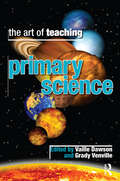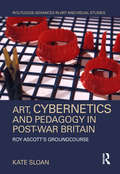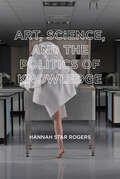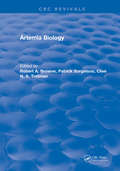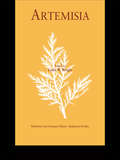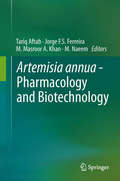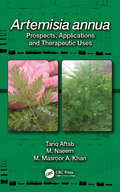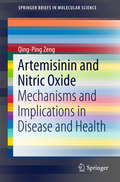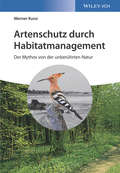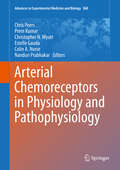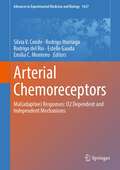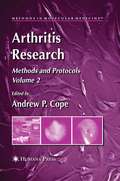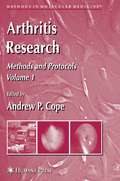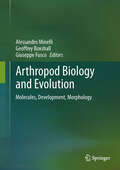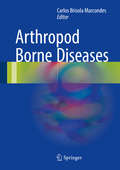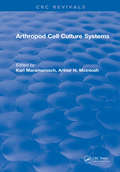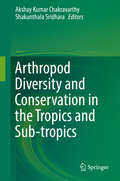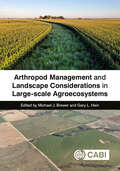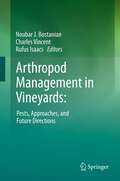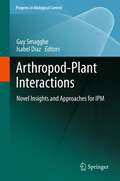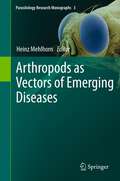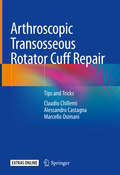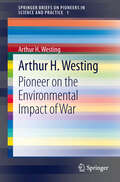- Table View
- List View
Art of Teaching Primary Science
by Grady Venville Vaille DawsonChildren have an innate curiosity about the natural world that makes teaching science a rewarding experience.However teaching science is an art that requires a unique combination of knowledge and skills to make the most of students' interest and foster their understanding. With contributions from leading educators, The Art of Teaching Primary Science addresses the fundamental issues in teaching science in primary and early childhood years.Reflecting current research in science education, The Art of Teaching Primary Science covers the following areas:* the theoretical underpinnings of science education and curriculum;* effective science teaching practice planning, teaching strategies, investigations, resources and assessment;* key issues including scientific literacy, integrating science and technology, and activities outside the classroom.The Art of Teaching Primary Science is invaluable for student teachers as a guide to the fundamentals of science education, and as a resource for experienced teachers to review and enhance their professional skills.'An excellent reference for those teachers of the primary years seeking the best ways to engage their students in good science and scientific investigation, and keen to link these with other learning areas.'Peter Turnbull, President, Australian Science Teachers Association
Art, Cybernetics and Pedagogy in Post-War Britain: Roy Ascott’s Groundcourse (Routledge Advances in Art and Visual Studies)
by Kate SloanThis is the first full-length study about the British artist Roy Ascott, one of the first cybernetic artists, with a career spanning seven decades to date. The book focuses on his early career, exploring the evolution of his early interests in communication in the context of the rich overlaps between art, science and engineering in Britain during the 1950s and 1960s. The first part of the book looks at Ascott’s training and early work. The second park looks solely at Groundcourse, Ascott’s extraordinary pedagogical model for visual arts and cybernetics which used an integrative and systems-based model, drawing in behaviourism, analogue machines, performance and games. Using hitherto unpublished photographs and documents, this book will establish a more prominent place for cybernetics in post-war British art.
Art, Science, and the Politics of Knowledge
by Hannah Star RogersHow the tools of STS can be used to understand art and science and the practices of these knowledge-making communities.In Art, Science, and the Politics of Knowledge, Hannah Star Rogers suggests that art and science are not as different from each other as we might assume. She shows how the tools of science and technology studies (STS) can be applied to artistic practice, offering new ways of thinking about people and objects that have largely fallen outside the scope of STS research. Arguing that the categories of art and science are labels with specific powers to order social worlds—and that art and science are best understood as networks that produce knowledge—Rogers shows, through a series of cases, the similarities and overlapping practices of these knowledge communities. The cases, which range from nineteenth-century artisans to contemporary bioartists, illustrate how art can provide the basis for a new subdiscipline called art, science, and technology studies (ASTS), offering hybrid tools for investigating art–science collaborations. Rogers&’s subjects include the work of father and son glassblowers, the Blaschkas, whose glass models, produced in the nineteenth century for use in biological classification, are now displayed as works of art; the physics photographs of documentary photographer Berenice Abbott; and a bioart lab that produces work functioning as both artwork and scientific output. Finally, Rogers, an STS scholar and contemporary art–science curator, draws on her own work to consider the concept of curation as a form of critical analysis.
Artemia Biology
by Robert A. BrowneArtemia is widely used in both life-sciences research and aquaculture. Although there are over 4000 references regarding Artemia, the literature is widely scattered. Artemia Biology provides a comprehensive, state-of-the-art review of this literature, containing a considerable amount of previously unpublished data. Although all aspects of Artemia biology are covered, the book emphasizes whole-organism approaches. Topics covered include molecular genetics, ontogeny, clonal diversity, mitochondrial DNA-based phylogeny, and comparisons of Artemia and Parartemia (including a taxonomic key to Parartemia species). The book also contains the latest information on Artemia culturing in fertilized ponds and culture tanks, as well as the use of the organism as a food source. Researchers investigating basic biological questions involving molecular genetics, biochemistry, enzymatic and developmental activities, physiology, ecological genetics and adaptation, ecology, and aquaculture production will find this book indispensable.
Artemisia (Medicinal And Aromatic Plants - Industrial Profiles Ser. #Vol. 18)
by Colin W. WrightA comprehensive overview of this genus, Artemisia examines all aspects of the herbs uses and applications, its mode of action and clinical importance. Following a comprehensive introduction to the genus, the book discusses the botanical, phytochemical and biological aspects of a number of important species of Artemisis. Considering that the discove
Artemisia annua - Pharmacology and Biotechnology
by Tariq Aftab Jorge F.S. Ferreira M. Masroor A. Khan M. NaeemArtemisinin, a sesquiterpene lactone originally extracted from the medicinal plant Artemisia annua L. , is an effective antimalarial agent, particularly for multi-drug resistant and cerebral malaria. However, the concentration of artemisinin in the plant is very low. Because the chemical synthesis of artemisinin is complicated and not economically feasible in view of the poor yield of the drug, the intact plant remains the only viable source of artemisinin production. Therefore, it is necessary to increase the concentration of artemisinin in A. annua to reduce the cost of artemisinin based antimalarial drugs. Plant scientists have focused their efforts on A. annua for a higher artemisinin crop yield. With the present volume, we are bringing together the research which is being done on this plant throughout the world and future possibilities for scientists and researchers who want to work on it.
Artemisia annua: Prospects, Applications and Therapeutic Uses
by Tariq Aftab M. Naeem M. Masroor A. KhanArtemisia annua is a well-known medicinal plant that has been utilized for a number of purposes, including malaria, for centuries. This is the first comprehensive book to cover the importance of Artemisia annua in the global health crisis and in the treatment against diseases. A component and extract, artemisinin, is the source of other derivatives which are also suitable for pharmaceutical use. The present demand for artemisinin far outpaces its supply. Researchers are working globally towards improving artemisinin content in the plant by various means. Artemisia annua: Prospects, Applications and Therapeutic Uses highlights the different approaches, including ‘omics', that are being used in current research on this immensely important medicinal plant. Providing comprehensive coverage of the agricultural and pharmaceutical uses of this plant, Artemisia annua will be essential reading for botanists, plant scientists, herbalists, pharmacognosists, pharmacologists and natural product chemists.
Artemisinin and Nitric Oxide: Mechanisms and Implications in Disease and Health (SpringerBriefs in Molecular Science)
by Qing-Ping ZengThis book discusses both the beneficial and harmful aspects of NO in biology and medicine, and also introduces the emerging discovery of artemisinin in antitumor, antibacterial infection, anti-inflammation, and antiaging contexts. In 1992 nitric oxide (NO) was voted "Molecule of the Year" by Science magazine, and the discovery of its physiological roles has led to Nobel Prize-winning work in neuroscience, physiology and immunology. The book explains why we should maintain a steady-state NO level that is derived from neuronal or epithelial NO synthase, and avoid the extremely high NO level resulting from inducible NO synthase. The book offers a valuable resource for medical chemists, clinicians, biologists and all those interested in health and disease.
Artenschutz durch Habitatmanagement: Der Mythos von der unberührten Natur
by Werner Kunz Josef H. ReichholfEin wichtiger Beitrag zur aktuellen Debatte über die Zukunft des Natur- und Artenschutzes, der zeigt, wie durch aktive Gestaltung von Lebensräumen die historische Artenvielfalt in Mitteleuropa erhalten werden kann.
Arterial Chemoreceptors in Physiology and Pathophysiology (Advances in Experimental Medicine and Biology #860)
by Chris Peers Colin A. Nurse Nanduri Prabhakar Prem Kumar Christopher N. Wyatt Estelle GaudaEvery three years, the International Society for Arterial Chemoreception (ISAC) arranges a Meeting to bring together all of the major International research groups investigating the general topic of oxygen sensing in health and disease, with a prime focus upon systemic level hypoxia and carotid body function. This volume summarises the proceedings of the XIXth meeting of the Society, held in Leeds, UK during the summer of 2014. As such this volume represents a unique collection of state of the art reviews and original, brief research articles covering all aspects of oxygen sensing, ranging from the molecular mechanisms of chemotransduction in oxygen sensing cells such as the carotid body type I cells, to the adverse, reflex cardiovascular outcomes arising from carotid body dysfunction as seen, for example, in heart failure or obstructive sleep apnoea. This volume will be of tremendous interest to basic scientists with an interest in the cellular and molecular biology of oxygen sensing and integrative, whole organism physiologists as well as physicians studying or treating the clinical cardiovascular consequences of carotid body dysfunction.
Arterial Chemoreceptors: Mal(adaptive) Responses: O2 Dependent and Independent Mechanisms (Advances in Experimental Medicine and Biology #1427)
by Estelle Gauda Sílvia V. Conde Rodrigo Iturriaga Rodrigo Del Rio Emília C. MonteiroThe book will contain reviews and brief research articles from the participants attending the International Society for Arterial Chemoreception (ISAC) meeting, to be held in Lisbon in Portugal in June/July 2020. Since ISAC was first established, almost 70 years ago, many advances in the classical field of arterial O2, CO2 and pH sensing have been achieved but the most impressive ones are probably related to the non-canonical roles of the carotid body, as its involvement in sympatho-mediated diseases. Over the recent years, the carotid body field has gained attention with the findings that carotid body dysfunction is associated with the development/maintenance of highly prevalent diseases from cardio-metabolic diseases to asthma. Knowing that most of the patients with these pathologies lack long-term disease control, it is imperative to define new pathophysiological mechanisms aiming to find new therapeutic targets for treatment and prevention. This book will cover a broad range of topics related, not only with the fundamental knowledge of the mechanisms related with the chemical sensing in the carotid body, but also with the adaptive and mal-adaptive responses of arterial chemoreceptors to O2-dependent and O2-independent mechanisms, namely with their impact on respiratory, cardiovascular, and metabolic homeostasis in healthy and disease conditions. This volume will be required text for all the researchers in the field of arterial chemoreceptors and will provide a valuable reference source for years to come.
Arthritis Research, Volume 2: Volume 2: Methods and Protocols (Methods in Molecular Medicine #136)
by Andrew P. CopeArthritis Research: Methods and Protocols is a compendium of data pertinent to the methods and protocols that have contributed to recent advances in molecular medicine in general, but to the molecular basis of rheumatic disease in particular. These volumes details novel technologies, some of which are still evolving and whose impacts are yet to be determined. Leaders in the field contribute to cover such exciting and cutting edge topics as imaging and immunohistochemistry, analysis of cartilage and bone catabolism, immunobiology, and cell trafficking.<P><P> In Volume 1, authors discuss synovial joint morphology, histopathology, and immunohistochemistry, cartilage matrix and bone biology, and cell trafficking, migration and invasion. Volume 2 is broken up into sections that cover immunobiology and T cells, animal models of arthritis, and applications of new technologies, such as Differential Display Reverse Transcription-Polymerase Chain Reaction (DDRT-PCR), to define novel therapeutic targets. Both volumes combine to produce a concise set of protocols condensing decades of experience and expertise.<P><P> Arthritis Research: Methods and Protocols will be a valuable tool for basic research investigators, clinician scientists, pathologists, immunologists, and biochemists looking to stay current in their fields.
Arthritis Research: Volume 1: Methods and Protocols (Methods in Molecular Medicine #135)
by Andrew P. CopeThis is a compendium of data pertinent to the methods and protocols that have contributed to recent advances in molecular medicine in general, but to the molecular basis of rheumatic disease in particular. These volumes details novel technologies, some of which are still evolving and whose impacts are yet to be determined. Leaders in the field contribute to cover exciting and cutting edge topics. This compendium will be a valuable tool.
Arthropod Biology and Evolution: Molecules, Development, Morphology
by Alessandro Minelli, Geoffrey Boxshall and Giuseppe FuscoMore than two thirds of all living organisms described to date belong to the phylum Arthropoda. But their diversity, as measured in terms of species number, is also accompanied by an amazing disparity in terms of body form, developmental processes, and adaptations to every inhabitable place on Earth, from the deepest marine abysses to the earth surface and the air. The Arthropoda also include one of the most fashionable and extensively studied of all model organisms, the fruit-fly, whose name is not only linked forever to Mendelian and population genetics, but has more recently come back to centre stage as one of the most important and more extensively investigated models in developmental genetics. This approach has completely changed our appreciation of some of the most characteristic traits of arthropods as are the origin and evolution of segments, their regional and individual specialization, and the origin and evolution of the appendages. At approximately the same time as developmental genetics was eventually turning into the major agent in the birth of evolutionary developmental biology (evo-devo), molecular phylogenetics was challenging the traditional views on arthropod phylogeny, including the relationships among the four major groups: insects, crustaceans, myriapods, and chelicerates. In the meantime, palaeontology was revealing an amazing number of extinct forms that on the one side have contributed to a radical revisitation of arthropod phylogeny, but on the other have provided evidence of a previously unexpected disparity of arthropod and arthropod-like forms that often challenge a clear-cut delimitation of the phylum.
Arthropod Borne Diseases
by Carlos Brisola MarcondesArthropod borne diseases cause enormous morbidity and mortality in most countries, mostly in those situated in tropical areas, but also in temperate regions. This book provides organized information on all arthropod related diseases, to prevent suffering and deaths, for medical students and professionals. Since arthropod borne diseases are present in many regions of the world and can even surprise professionals and lays in non-endemic regions, like malaria in UK and Canada, the author and its many expert collaborators are sure that it will be essential in all hospitals, clinics and medical libraries around the world. As arthropod borne diseases of domesticated animals are very numerous and in some cases related to human diseases, they are also included in the book.
Arthropod Cell Culture Systems
by Karl MaramoroschInvertebrate cell culture is increasingly being used in various areas of biological research. Research in cellular biology and pathology that previously depended primarily on in vitro investigations of vertebrate animal cell systems is now being conducted using invertebrate cells. Specialists and pioneers from the United States, Japan, Switzerland, Slovakia, and China have presented original contributions to create a well-balanced cross-section of current developments. Topics discussed include the preparation of cell culture media; cultivation of mosquito, lepidopteran, grasshopper, and tick cells; the application of such cells to mammalian and plant virus research; and diverse applications in medicine, biology, and agriculture. A special chapter devoted to the work of Japanese cell culture pioneers is also featured. All chapters are supported by tables, photographs, and up-to-date bibliographies.
Arthropod Diversity and Conservation in the Tropics and Sub-tropics
by Akshay Kumar Chakravarthy Shakunthala SridharaArthropods are invertebrates that constitute over 90% of the animal kingdom, and their bio-ecology is closely linked with global functioning and survival. Arthropods play an important role in maintaining the health of ecosystems, provide livelihoods and nutrition to human communities, and are important indicators of environmental change. Yet the population trends of several arthropods species show them to be in decline. Arthropods constitute a dominant group with 1. 2 million species influencing earth's biodiversity. Among arthropods, insects are predominant, with ca. 1 million species and having evolved some 350 million years ago. Arthropods are closely associated with living and non-living entities alike, making the ecosystem services they provide crucially important. In order to be effective, plans for the conservation of arthropods and ecosystems should include a mixture of strategies like protecting key habitats and genomic studies to formulate relevant policies for in situ and ex situ conservation. This two-volume book focuses on capturing the essentials of arthropod inventories, biology, and conservation. Further, it seeks to identify the mechanisms by which arthropod populations can be sustained in terrestrial and aquatic ecosystems, and by means of which certain problematic species be managed without producing harmful environmental side-effects. This edited compilation includes chapters contributed by over 80 biologists on a wide range of topics embracing the diversity, distribution, utility and conservation of arthropods and select groups of insect taxa. More importantly, it describes in detail the mechanisms of sustaining arthropod ecosystems, services and populations. It addresses the contribution of modern biological tools such as molecular and genetic techniques regulating gene expression, as well as conventional, indigenous practices in arthropod conservation. The contributors reiterate the importance of documenting and understanding the biology of arthropods from a holistic perspective before addressing conservation issues at large. This book offers a valuable resource for all zoologists, entomologists, ecologists, conservation biologists, policy makers, teachers and students interested in the conservation of biological resources.
Arthropod Management and Landscape Considerations in Large-Scale Agroecosystems
by Matthew O'Neal Steven E. Naranjo Ian MacRae Kristopher L Giles Tom Royer Peter C Ellsworth Kristen Baum Mahendra Bhandari Haley Butler Hannalene Du Plessis Norman C. Elliott Sarah Elzay Isaac L. Esquivel Ashleigh M. Faris Aaron J. Gassmann Maura Hall Louis S. Hesler Anders S. Huseth William D. Hutchison Robert L. Meagher Jr Lance J. Meinke Shannon L. Osborne Pankaj Pal Katherine A. Parys Dominic Reisig Nina Rudin Thomas W. Sappington Gregory A. Sword Ashley E. Tessnow Paul A. Umina Johnnie Van BergFor large-scale agroecosystems, patterns of pest population increases (graded increases or abrupt outbreaks) and declines (graded suppression or abrupt crashes) vary considerably and are influenced by factors within crop fields and across broader landscape scales. Better understanding of pest population dynamics and the implications of spatial interactions on the function and development of pest management approaches are the main themes of this important book. The book builds from a 60+ year history of field-based pest management by focusing on the drivers of pest management in large-scale agroecosystems and the landscape-scale processes that affect these drivers and contribute to variation in pest outbreaks and suppression. These drivers include abiotic and biotic influences such as weather, spatial composition and arrangement of landscape elements, and widely applied managed inputs such as planting and crop rotation schedules, crop varietal selection, and land and soil conservation efforts. The book introduces general concepts, opportunities, and challenges of arthropod management in large-scale agroecosystems. Case studies from major field crop-based agroecosystems are used to present research approaches and improve understanding and management of pest and beneficial insects in large-scale agroecosystems. Specific research findings are provided on multi-trophic interactions within the system as influenced by climate, landscape, and other ecological, agricultural, and social/economic components of the agroecosystem. The book concludes with a synthesis of these concepts and prospectus for future research and developments in arthropod management in large-scale, plant-based agroecosystems. The book is essential reading for researchers in applied entomology and ecology and for pest management practitioners.
Arthropod Management in Vineyards: Pests, Approaches, and Future Directions
by Charles Vincent Rufus Isaacs Noubar J. BostanianProvides a state-of-the-science overview of arthropods affecting grape production around the world. Vineyard pest management is a dynamic and evolving field, and the contributed chapters provide insights into arthropods that limit this important crop and its products. Written by international experts from the major grape-growing regions, it provides a global overview of arthropods affecting vines and the novel strategies being used to prevent economic losses, including invasive pests affecting viticulture. The book contains reviews of the theoretical basis of integrated pest management, multiple chapters on biological control, current status of chemical control, as well as in-depth and well-illustrated reviews of the major arthropod pests affecting grape production and how they are being managed worldwide. This text will serve as a primary resource for applied entomologists, students, growers, and consultants with interests at the intersection of viticulture and applied entomology.
Arthropod-Plant Interactions: Novel Insights and Approaches for IPM (Progress in Biological Control #14)
by Guy Smagghe Isabel DiazThe book consists of multiple chapters by leading experts on the different aspects in the unique relationship between arthropods and plants, the underlying mechanisms, realized successes and failures of interactions and application for IPM, and future lines of research and perspectives. Interesting is the availability of the current genomes of different insects, mites and nematodes and different important plants and agricultural crops to bring better insights in the cross talk mechanisms and interacting players. This book will be the first one that integrates all this fascinating and newest (from the last 5 years) information from different leading research laboratories in the world and with perspectives from academia, government and industry.
Arthropods as Vectors of Emerging Diseases: Arthropods As Vectors Of Emerging Diseases (Parasitology Research Monographs #3)
by Heinz MehlhornGlobal warming and globalization are the buzzwords of our time. They have nearly reached a religious status and those who deny their existence are considered modern heretics. Nevertheless, the earth has become an overcrowded village, traversable within a single day. Thus it is hardly surprising that besides persons and goods also agents of disease are easily transported daily from one end of the world to the other, threatening the health and lives of billions of humans and their animals. Agents of diseases (prions, viruses, bacteria, fungi and parasites) are not only transmitted by body contact or direct exchange of bodily fluids, but also by means of vectors which belong to the groups of licking or blood-sucking arthropods (mites, ticks, insects) that live close to humans and their houses. Without a doubt the recently accelerating globalization supports the import of agents of disease into countries where they never had been or where they had long since been eradicated, leading to a false sense of living on a "safe island." These newly imported or reintroduced diseases - called "emerging diseases" - may lead to severe outbreaks in cases where the countries are not prepared to combat them, or in cases where viruses are introduced that cannot be controlled by medications or vaccines. Arthropods are well known vectors for the spread of diseases. Thus their invasion from foreign countries and their spreading close to human dwellings must be blocked everywhere (in donor and receptor countries) using safe and effective measures. This book presents reviews on examples of such arthropod-borne emerging diseases that lurk on the fringes of our crowded megacities. The following topics show that there is an ongoing invasion of potential vectors and that control measures must be used now in order to avoid disastrous outbreaks of mass diseases.
Arthroscopic Transosseous Rotator Cuff Repair: Tips and Tricks
by Marcello Osimani Claudio Chillemi Alessandro CastagnaThe book offers a comprehensive and up-to-date guide to the cutting edge arthroscopic transosseous techniques for the treatment of rotator cuff tears, which are gradually taking over from the common open surgical approach, defined as the gold standard for RCR. With the help of numerous figures, it presents step by step a novel all-arthroscopic anchorless transosseous suture technique that is less invasive and easier to perform. After discussing the etiopathogenesis, histopathology and radiological classification of rotator cuff tears, the book reviews all possible arthroscopic procedures and explores in detail suture management, describing single and double tunnel options. It also examines the complications and post-operative rehabilitation and imaging, while the closing chapter addresses the economic aspects of daily use. Intended primarily for arthroscopic surgeons interested in the field of shoulder joint repair, this exhaustive guide is also a valuable resource for residents and shoulder specialists.
Arthur E. Haas - The Hidden Pioneer of Quantum Mechanics: A Biography (Springer Biographies)
by Michael WiescherThe book highlights the personal and scientific struggles of Arthur Erich Haas (1884-1941), an Austrian Physicist from a wealthy Jewish middle-class family, whose remarkable accomplishments in a politically hostile but scientifically rewarding environment deserve greater recognition.Haas was a fellow student of both Lise Meitner and Erwin Schrödinger and was also one of the last doctoral students of Ludwig Boltzmann. Following Boltzmann's suicide, Haas was forced to submit a more independent doctoral thesis in which he postulated new approaches in early quantum theory, actually introducing the idea of the Bohr radius before Niels Bohr. It is the lost story of a trailblazer in the fields of quantum mechanics and cosmology, a herald of nuclear energy and applications of modern science. This biography of Haas is based on new and previously unpublished family records and archived material from the Vienna Academy of Science and the University of Notre Dame, which the author has collected over many years. From his analysis of the letters, documents, and photos that rested for nearly a century in family attics and academic archives, Michael Wiescher provides a unique and detailed insight into the life of a gifted Jewish physicist during the first half of the twentieth century. It also sheds light on the scientific developments and thinking of the time. It appeals not only to historians and physicists, but also general readers. All appreciate the record of Haas’ interactions with many of the key figures who helped to found modern physics.
Arthur H. Westing: Pioneer on the Environmental Impact of War (SpringerBriefs on Pioneers in Science and Practice #1)
by Arthur H. WestingSince the 1960s the environment has become an issue of increasing public concern in North America and elsewhere. Triggered by the Second Indochina War (Vietnam Conflict) of 1961-1975, and further encouraged by the International Conference on the Human Environment, held in Stockholm in 1972, the environmental impact of war emerged and grew as a topic of research in the natural and the social sciences. And in the late 1980s this led additionally to a focus and debate on environmental security. Arthur Westing, a forest ecologist, was a major pioneer contributing and framing both of those debates conceptually, theoretically, and empirically, starting with Harvest of Death: Chemical Warfare in Vietnam and Cambodia (1972) (co-authored with wildlife biologist E.W. Pfeiffer and others). As a Senior Researcher at the Stockholm and Oslo International Peace Research Institutes (SIPRI and PRIO), and as a Professor of Ecology at Windham and Hampshire Colleges, Westing authored and edited books on Ecological Consequences of the Second Indochina War (1976), Weapons of Mass Destruction and the Environment (1977), Warfare in a Fragile World: Military Impact on the Human Environment (1980), Herbicides in War: the Long-term Ecological and Human Consequences (1984), Environmental Warfare: a Technical, Legal and Policy Appraisal (1984), Explosive Remnants of War: Mitigating the Environmental Effects (1985), Global Resources and International Conflict: Environmental Factors in Strategic Policy and Action (1986), Cultural Norms, War and the Environment (1988), Comprehensive Security for the Baltic: an Environmental Approach (1989), and Environmental Hazards of War: Releasing Dangerous Forces in an Industrialized World (1990) --- as well as authoring numerous UN reports, book chapters, and journal articles. This volume combines six of his pioneering contributions on the environmental consequences of warfare in Viet Nam and in Kuwait, on the environmental impact of nuclear war, and on legal constraints and military guidelines for protecting the environment in wartime
Arthur M. Sackler COLLOQUIA OF THE NATIONAL ACADEMY OF SCIENCES: Self-Organized Complexity in the Physical, Biological, and Social Sciences
by Engineering National Academies of SciencesThe National Academies Press (NAP)--publisher for the National Academies--publishes more than 200 books a year offering the most authoritative views, definitive information, and groundbreaking recommendations on a wide range of topics in science, engineering, and health. <P><P>Our books are unique in that they are authored by the nation's leading experts in every scientific field.
